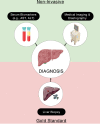A Comprehensive Review of Liver Allograft Fibrosis and Steatosis: From Cause to Diagnosis
- PMID: 37854023
- PMCID: PMC10581596
- DOI: 10.1097/TXD.0000000000001547
A Comprehensive Review of Liver Allograft Fibrosis and Steatosis: From Cause to Diagnosis
Abstract
Despite advances in posttransplant care, long-term outcomes for liver transplant recipients remain unchanged. Approximately 25% of recipients will advance to graft cirrhosis and require retransplantation. Graft fibrosis progresses in the context of de novo or recurrent disease. Recurrent hepatitis C virus infection was previously the most important cause of graft failure but is now curable in the majority of patients. However, with an increasing prevalence of obesity and diabetes and nonalcoholic fatty liver disease as the most rapidly increasing indication for liver transplantation, metabolic dysfunction-associated liver injury is anticipated to become an important cause of graft fibrosis alongside alloimmune hepatitis and alcoholic liver disease. To better understand the landscape of the graft fibrosis literature, we summarize the associated epidemiology, cause, potential mechanisms, diagnosis, and complications. We additionally highlight the need for better noninvasive methods to ameliorate the management of graft fibrosis. Some examples include leveraging the microbiome, genetic, and machine learning methods to address these limitations. Overall, graft fibrosis is routinely seen by transplant clinicians, but it requires a better understanding of its underlying biology and contributors that can help inform diagnostic and therapeutic practices.
Copyright © 2023 The Author(s). Transplantation Direct. Published by Wolters Kluwer Health, Inc.
Conflict of interest statement
The authors declare no conflicts of interest.
Figures


Similar articles
-
Association between obesity after liver transplantation and steatosis, inflammation, and fibrosis of the graft.Clin Transplant. 2020 Dec;34(12):e14093. doi: 10.1111/ctr.14093. Epub 2020 Oct 19. Clin Transplant. 2020. PMID: 32970896
-
Noninvasive markers of liver steatosis and fibrosis after liver transplantation - Where do we stand?World J Transplant. 2021 Mar 18;11(3):37-53. doi: 10.5500/wjt.v11.i3.37. World J Transplant. 2021. PMID: 33816145 Free PMC article. Review.
-
Predictors of De Novo Nonalcoholic Fatty Liver Disease After Liver Transplantation and Associated Fibrosis.Liver Transpl. 2019 Jan;25(1):56-67. doi: 10.1002/lt.25338. Liver Transpl. 2019. PMID: 30609189
-
To transplant or not to transplant recurrent hepatitis C and liver failure.Clin Liver Dis. 2003 Aug;7(3):615-29. doi: 10.1016/s1089-3261(03)00053-9. Clin Liver Dis. 2003. PMID: 14509530 Review.
-
Severe recurrent hepatitis C after liver retransplantation for hepatitis C virus-related graft cirrhosis.Liver Transpl. 2003 Mar;9(3):228-35. doi: 10.1053/jlts.2003.50029. Liver Transpl. 2003. PMID: 12619018
Cited by
-
The impact of donor liver fibrosis on the outcomes of patients who undergo liver transplant: a cohort study from UNOS database.Front Med (Lausanne). 2025 Apr 10;12:1547200. doi: 10.3389/fmed.2025.1547200. eCollection 2025. Front Med (Lausanne). 2025. PMID: 40276744 Free PMC article.
References
-
- Rana A, Ackah RL, Webb GJ, et al. . No gains in long-term survival after liver transplantation over the past three decades. Ann Surg. 2019;269:20–27. - PubMed
-
- Hübscher SG. What is the long-term outcome of the liver allograft? J Hepatol. 2011;55:702–717. - PubMed
-
- Adams DH, Sanchez-Fueyo A, Samuel D. From immunosuppression to tolerance. J Hepatol. 2015;62(1, Supplement):S170–S185. - PubMed
-
- Watt KDS, Charlton MR. Metabolic syndrome and liver transplantation: a review and guide to management. J Hepatol. 2010;53:199–206. - PubMed
Publication types
LinkOut - more resources
Full Text Sources

